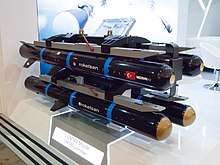UMTAS
UMTAS or Mizrak-U (Uzun Menzilli Tanksavar Sistemi) is a long range air-to-surface anti-tank missile developed by Turkish armor and missile manufacturer ROKETSAN.[2][3][4]
| UMTAS Long Range Antitank Missile System | |
|---|---|
 UMTAS missiles displayed on helicopter pylon | |
| Type | Air-to-surface, Anti-tank missile |
| Place of origin | Turkey |
| Production history | |
| Manufacturer | Roketsan A.Ş. |
| Specifications | |
| Mass | 37.5 kg[1] |
| Length | 175 cm |
| Diameter | 16 cm |
| Warhead | Insensitive Anti-armor Tandem Warhead |
| Engine | Solid-fuel rocket |
Operational range | 500–8,000 m |
Guidance system | Two-way RF Data-link Imaging Infrared Seeker or Laser guidance |
Launch platform | Rotary wing platforms Unmanned combat air vehicle Land combat vehicle Naval platforms |
| Launch and Warhead test | |
Background
The UMTAS program was initiated in 2005 by Turkey's Undersecretariat for Defence Industries (SSM), specifically to provide T-129 ATAK combat helicopters with an indigenous guided missile.
The UMTAS has been designed to engage tanks and heavily armoured vehicles.[5] It can be integrated to various platforms (Helicopters, UAVs, Land Vehicles, Stationary Platforms, Light Assault Aircraft, Naval Platforms)[6]
Description
The UMTAS missile features "fire and forget" and "fire and update" infrared guidance with a tandem anti-armor warhead. It is capable of engaging targets at 8 kilometers.
Capabilities:[1]
- Lock-on before and after launch
- Can be used in day or night and in adverse weather conditions
- Tandem warhead, effective against reactive armors
- Insensitive munition characteristics against liquid fuel fire and bullet hits
- Communication of seeker image to the user and command by user using Data Link.
The laser guided version is marketed as the L-UMTAS[6]
Development
Phase 1 (design) was launched in 2005 and completed in 2008.[1]
Phase 2 (development and qualification) was launched in 2008 and completed in 2015.[5]
The L-UMTAS and UMTAS version have been successfully integrated and fired from the Turkish T-129 ATAK helicopter against land targets and from SH-60 Sea HAWKs against sea targets.
The missile has also been successfully tested fired from the Bayraktar Tactical UAS (Bayraktar TB2 UCAV) Drone. The missile was dropped from an altitude of 16,000 ft. to hit a 2×2 meter laser-designated target self designated from the drone, at a distance of 8,000 meters.[7]
Serial production has begun with the delivery dates set in 2016.[5]
References
- LONG RANGE ANTITANK MISSILE (LRAT) Archived 2011-06-16 at the Wayback Machine, Roketsan, Retrieved October 11, 2010
- "UMTAS Long Range Anti-Tank Missile System - Army Technology". Archived from the original on 2019-03-24.
- UMTAS (Long Range Anti Tank System) (Turkey) Archived 2010-04-28 at the Wayback Machine, Jane's Information Group, Retrieved October 10, 2010
- "Archived copy". Archived from the original on 2019-04-14. Retrieved 2019-07-22.CS1 maint: archived copy as title (link)
- "Roketsan Shows Broad Capabilities". aviationweek.com. Archived from the original on 2016-06-02. Retrieved 2016-04-28.
- "Long Range Anti-Tank Missile UMTAS « Roketsan". www.roketsan.com.tr. Archived from the original on 2016-04-27. Retrieved 2016-04-28.
- Eshel, Tamir. "Turkish UMTAS Missile Dropped From a Bayraktar Tactical Drone | Defense Update:". defense-update.com. Archived from the original on 2016-04-13. Retrieved 2016-04-28.